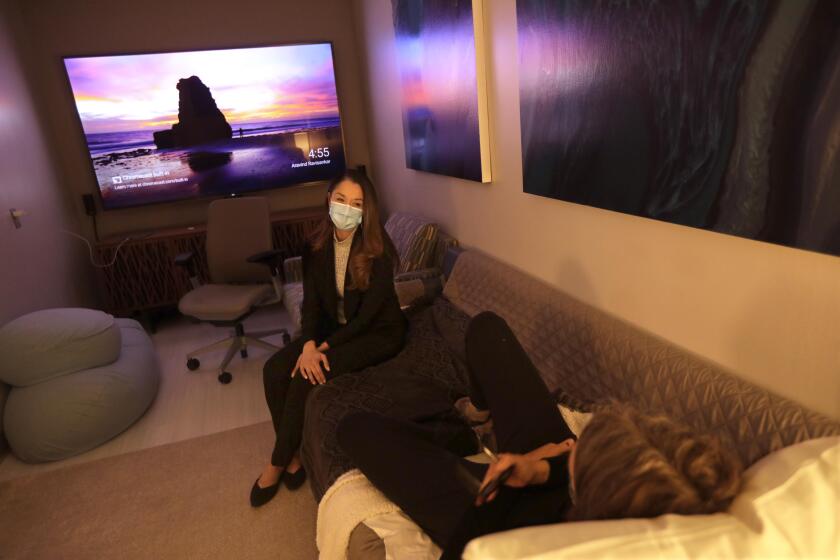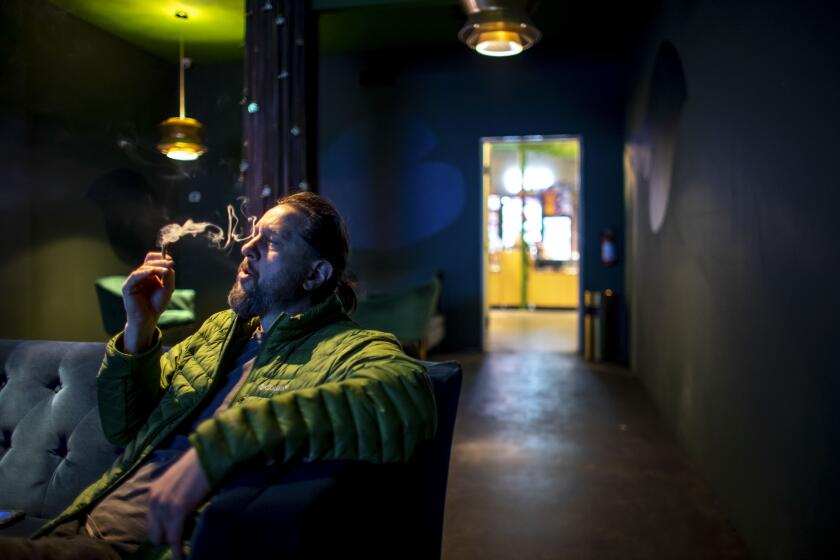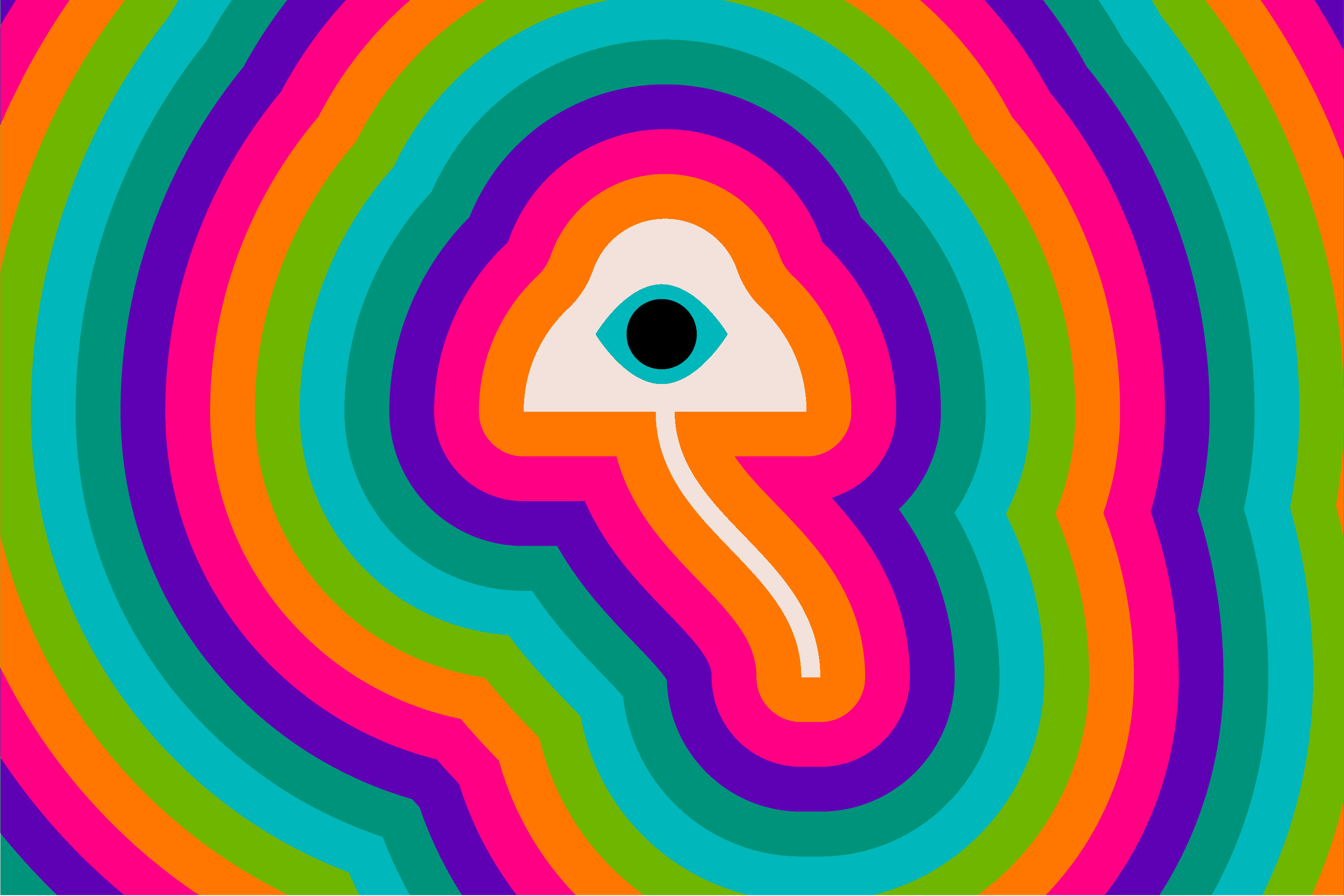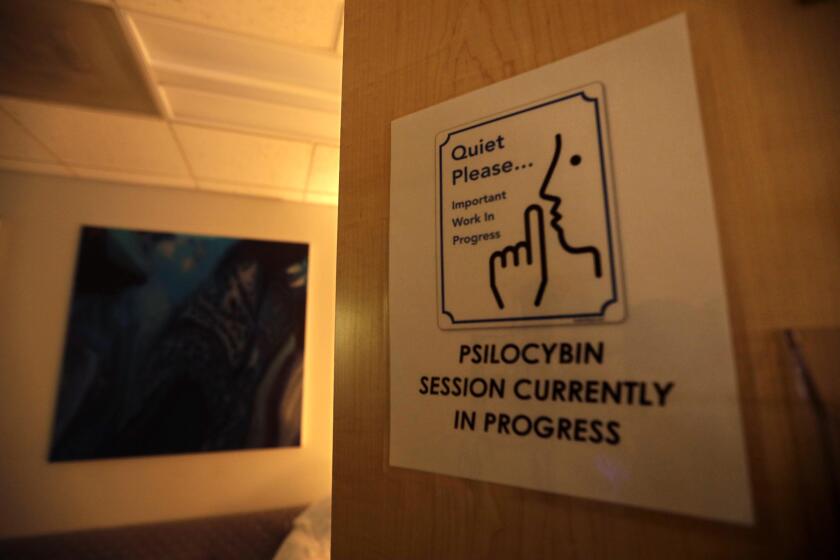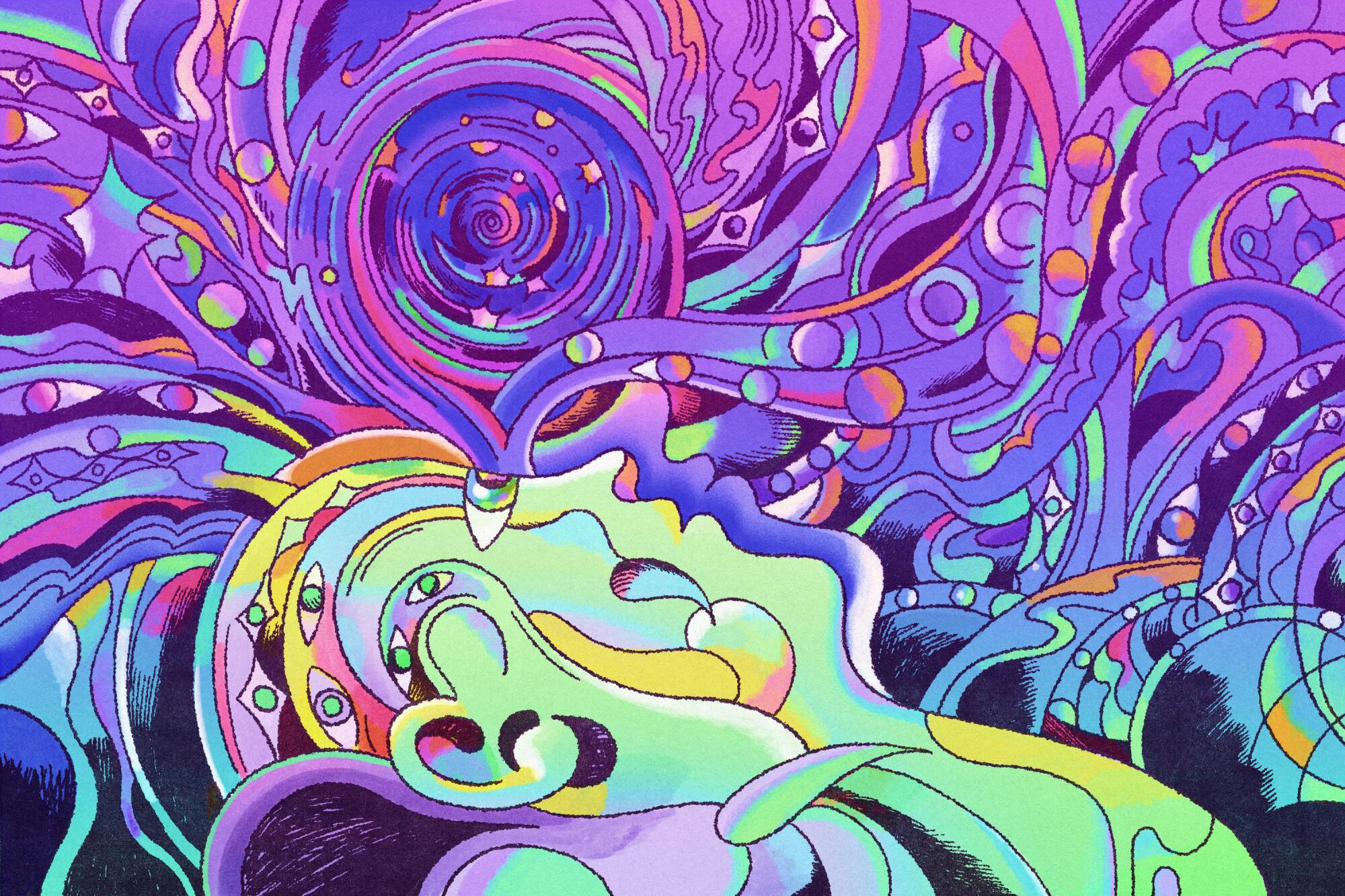
- Share via
I’m familiar with magic mushrooms from back in the day. I took them a couple times in college — including on a particularly memorable Halloween — and thoroughly enjoyed the experience. So I was curious about a Santa Monica-based startup called the Reality Center that’s been trying to expand the mind and aid in healing the body via digital psychedelics — a proprietary combination of pulsing lights, sounds and vibrations — instead of consuming drugs.
Psilocybin, the active ingredient in magic mushrooms, is enjoying a peak pop-culture popularity not seen since the 1970s. Although illegal at the federal level, its consciousness-altering properties have shown promise in helping to treat PTSD, depression, anxiety and addiction. And recently I’ve heard Angelenos at cocktail parties swapping stories about their adventures in microdosing mushrooms (taking extremely small amounts) as casually as they might have discussed cannabis a decade ago.
Psilocybin and many other psychedelics are broadly prohibited under federal law. But U.S. researchers have been legally scrutinizing their use in scores of clinical trials.
The use of psilocybin mushrooms was legalized in Oregon in 2020 and decriminalized in Colorado as of January, but recent efforts to give similar access to Californians have so far been unsuccessful (though a handful of cities — including San Francisco, Oakland and Santa Cruz — have passed resolutions effectively decriminalizing magic mushrooms).
For Angelenos, that means experimenting with psychedelic drugs requires breaking the law or taking a trip — as in an actual physical one — to one of the above shroom-friendly locales.
That made the idea of taking a legal psychedelic trip right here in Southern California (even under the guise of “sensory wellness”) appealing, though the price tag — $249 for a 60-minute session — gave me pause. Could a drug-free drug trip be worth that much? Especially when compared to the cost of magic mushrooms in the decriminalized marketplace? (Shelby Hartman, co-founder and editor-in-chief of L.A.-based psychedelics-focused magazine DoubleBlind, said an eighth of an ounce of whole, dried psilocybin mushrooms — enough for a serious trip — is currently “somewhere around $40 to $50.” That means flying round-trip to Denver and munching magic mushrooms the old-fashioned way would be about the same price as an hourlong digital trip.)
Pot smokers looking for social sesh options should consider heading to Palm Springs, which has 10 licensed consumption lounges compared to L.A.’s zero.
But if the Reality Center’s magic technology really could alter someone’s consciousness the way magic mushrooms or other psychedelic compounds could, especially over several sessions (the company says the benefits increase over multiple sessions), maybe the results — therapeutic or recreational — would be worth every consciousness-expanding penny. There was only one way to find out.
I booked an hourlong session (and used a promo code for new customers, saving me $50 off my first session) via the Reality Center’s website, and then filled out two follow-up documents including a medical waiver (attesting that I didn’t have any implanted medical devices, photosensitivity or epilepsy). The other was a kind of New-Agey questionnaire that asked about my goals for the session, my astrological sign and my least favorite color.
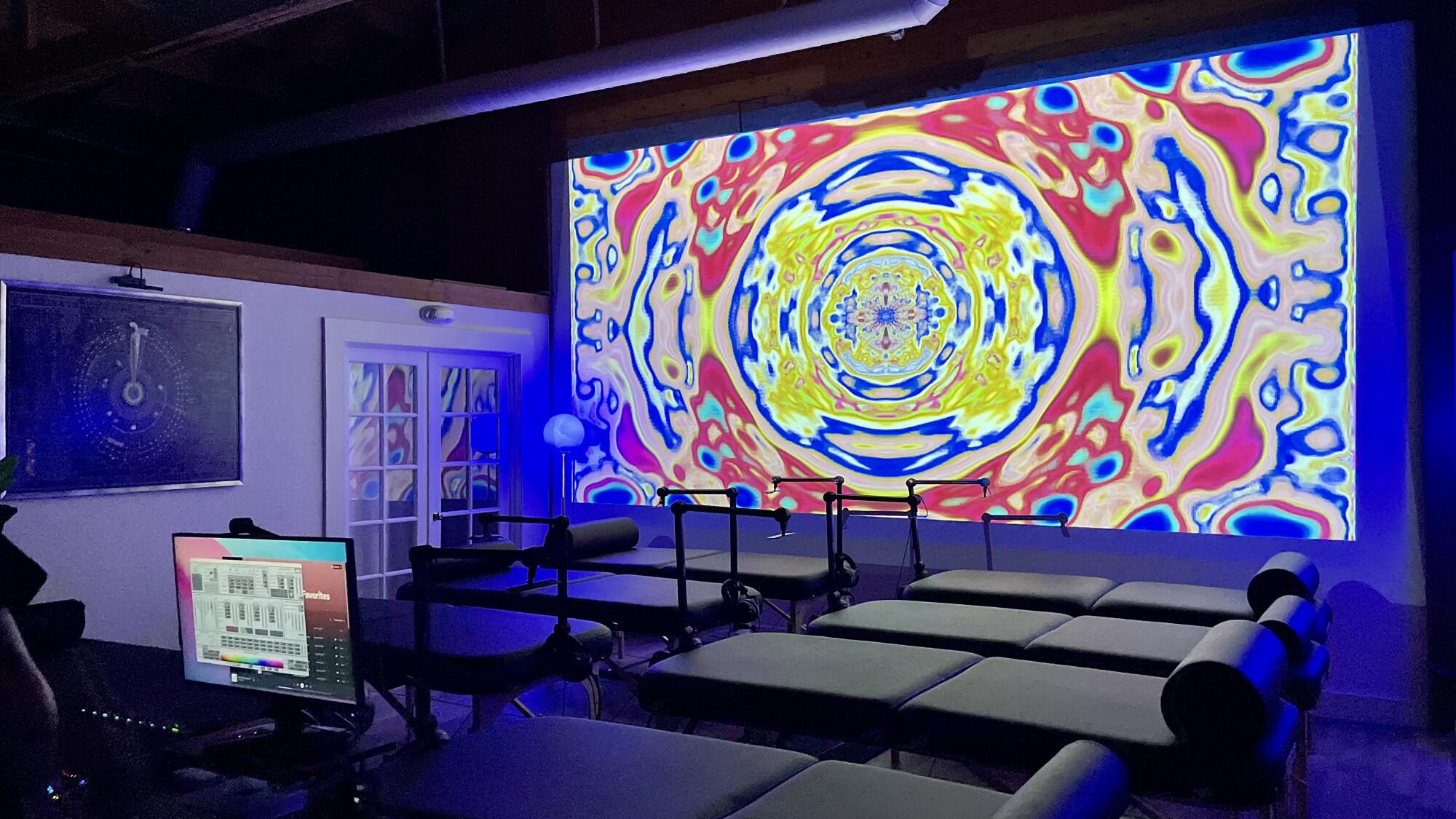
A few days later, I was on a bustling stretch of Santa Monica’s Second Street, where the portal to expanded consciousness appeared to be sandwiched between a hostel and a hot yoga studio. I found four other adventurous spirits were already queued up outside.
We were all ushered inside a dimly lit cluster of rooms by Tarun Raj and Jonathan Chia. (The former an artist and inventor and the latter a U.S. Army combat veteran, they co-founded the company with Benji Tucker and Don Estes.) The largest of the rooms inside the Reality Center felt like a trendy Hollywood fitness space set up inside a high-tech recording studio with a handful of massage tables in the middle, a trippy wall-sized video screen on one side and a rave-worthy stack of audio and visual equipment topped with a computer screen on the other.
“What we’re doing is sort of like neuroscience DJing,” Raj said after someone pointed out the equipment’s resemblance to a DJ setup. He explained that the role of the person behind the controls (known as the “reality manager”) is to use the various sensory inputs to, in his words, “jump-start” the mind and body and move it toward a near-meditative state. It’s an approach based on Estes’ theory of sensory resonance, which posits that the body’s autonomic nervous system can essentially be “reset” by synchronizing all of the major sensory mechanisms together — visual, aural and vibrational.
The foursome of aspiring psychonauts I’d arrived with would be launching from this room, which Chia said can accommodate groups of up to eight people at a time.
Smaller rooms around the periphery were set up for different scenarios. One space was for vocal analysis (which includes creating a kind of visual voice print designed to help you amplify and manifest your intent), one for postsession integration, one for a two-person experience (“Like when couples get a massage together,” Chia said) and one for the Wavetable experience. It was this last room that was to be my departure lounge.
Chia, who was my session’s reality manager, first asked me to remove my shoes and glasses and lie down on what looked — and felt — like a massage table with a foot-thick soft-sided waterbed layered on top. He explained that the mineral-heavy liquid inside the squishy layer was designed to mimic that of the human body. As I prepared to take my journey, Chia shared a little bit of his own.
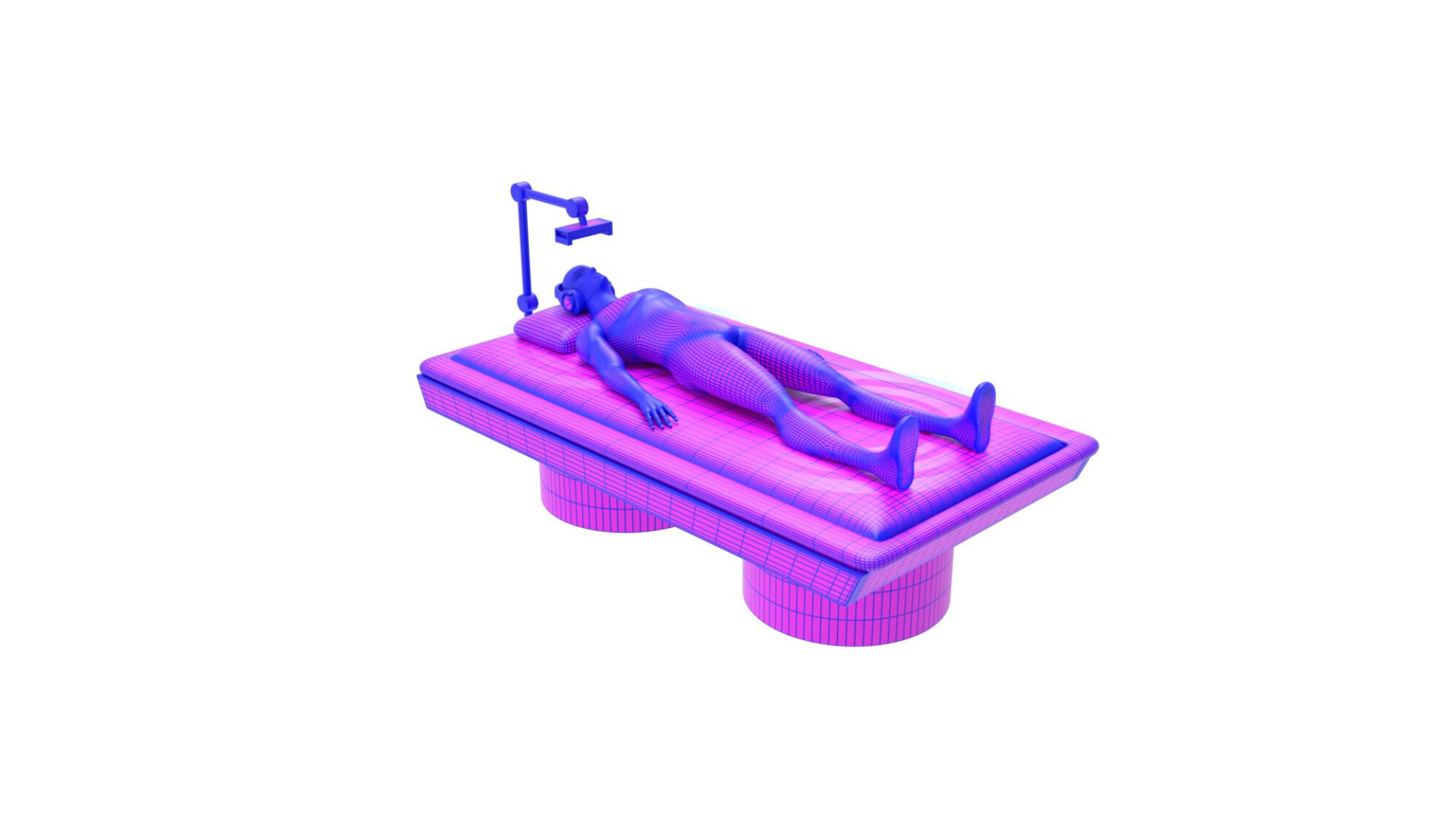
As a military veteran, he had originally tried to treat his post-traumatic stress by self-medicating with drugs and alcohol. His path to sensory wellness began after Raj, a longtime friend, introduced him to the healing power of reiki. Fast-forward to January 2022 when, having joined forces with Tucker and Estes, the Reality Center became a reality.
My session started with Chia leading me through some simple breathing exercises. Then he asked me to imagine myself in one of my favorite places (I pictured a mossy, wooded glen near my family home in Vermont) surrounded by the people who were important in my life (I imagined my family — a generation in each direction — with everyone wearing white like in the Season 1 finale of “Modern Family”). “You are rooted like a sequoia,” he said calmly into my headset, “strong and reaching up toward the sky.”
From here on out, things got next level pretty quickly. With my eyes firmly closed, I could full-on “see” the pulsing lights positioned just inches from my face — mostly cascading, melting and swirling whorls of color. Chanting, tinkling bells and crashing waves swelled into my headphones at the same time as rumbling and vibrating increased on all sides of me. From time to time, I could hear calming spoken-word snippets (“We find one ember. And very gently we fan that ember. Blow on it, it gets brighter. And from that ember we rebuild the fire ...”).
Psilocybin, the psychoactive component of “magic mushrooms,” is the most-studied psychedelic, but there’s a lot we don’t know about how it works.
Maybe halfway through, I became unmoored — detached as if I’d suddenly been cut free from a parasailing tether I didn’t know I’d been connected to my whole life. I had the sensation of hurtling through space. When waves crashed in my ears in concert with the rumbling beneath me and the rippling patterns lit up my optic nerves, it seemed as if I was nothing but sand passing through a reality sieve, all my constituent molecules dissolving at the waterline of a vast ocean.
I was one with the swirling fractal rainbow aura at the center of the universe and, for a brief moment, it felt as if I was staring backward through time to observe my own swirling double-helix strands of DNA taking shape out of the cosmic soup of nothingness. I felt hot tears well into the corners of scrunched-shut eyes. They were tears of gratitude, tears of suddenly feeling at peace, as if just for a nanosecond I’d been lucky enough to get a glimpse behind the curtain, to peek at the run-of-show road map of the universe and see where my dust-speck self fit into it.
Eventually, the sound, the pulsing lights and the vibrations began to ebb. As I once again became aware of my surroundings, I heard Chia’s voice urging me to take a few deep, centering breaths.
The possession and personal use of “magic mushrooms” and ayahuasca could be decriminalized under a new psychedelics bill introduced Monday backed by veterans.
As I sat up, things seemed that kind of clean-windshield different you feel after a particularly good therapy session. I had the sense that many hours had passed, though Chia assured me only 56 minutes had elapsed since I had removed my shoes and glasses. As I left the Reality Center and walked across the street to my car, the sun felt brighter.
Was it my imagination or did the abstract design painted over the bank of elevators really look like the fractals I’d just seen from behind closed eyes? And was that the throaty rumble of passing cars synchronizing with the nearly imperceptible vibrations in my solar plexus?
Some of those feelings could be a kind of immediate-post-experience placebo effect, but a full week later I still saw things — large and small — that remind me of that midsession moment when I looked the universe right in the all-seeing eye and saw it wink at me. I see it in the hummingbirds flitting past my window, hear it in the gurgle of my emptying dishwasher and feel it in the vibration of the cellphone in my pocket.
While interest in magic mushrooms, or psilocybin, is driving renewed cultural interest in mushrooms, non-psychedelic fungi are also capturing our attention.
So, yeah, the ride was well worth the ticket price for me. And here are several reasons why it might be worth it for you too.
1. It’s totally legal
This is probably the biggest upside of taking a technodelic trip. Even if you go to a place where psilocybin has been decriminalized under state (or city) law, its status as a Schedule 1 drug at the federal level will make it a nonstarter for many people. (And tripping while keeping one eye open for the man isn’t exactly relaxing.) That’s not an issue with digital psychedelics. Unless you happen to live somewhere where music, pulsing lights and vibrating massage tables are against the law — in which case you’ve got more problems than psychedelics can solve.
2. $249 is the ceiling — not the floor
The price I paid was for one of the more expensive experiences: a 60-minute session on the waterbed-like Wavetable. Also on offer are half-hour sessions with the same set-up (for $149) and a couple of options that swap out the squishy layer of mineral-heavy liquid for a vibrating massage table (one hour for $99, a half-hour for $59). That’s not including any potential first-timer discounts like the promo code that shaved $50 off my maiden voyage.
The cost of a session could drop all the way to zero if you’re a qualifying military veteran. According to Chia, since it opened last year, the center has provided free treatments to 250 veterans and their families and discounted services to another 50. (Interested veterans should reach out to the Reality Center through its website for additional information.)
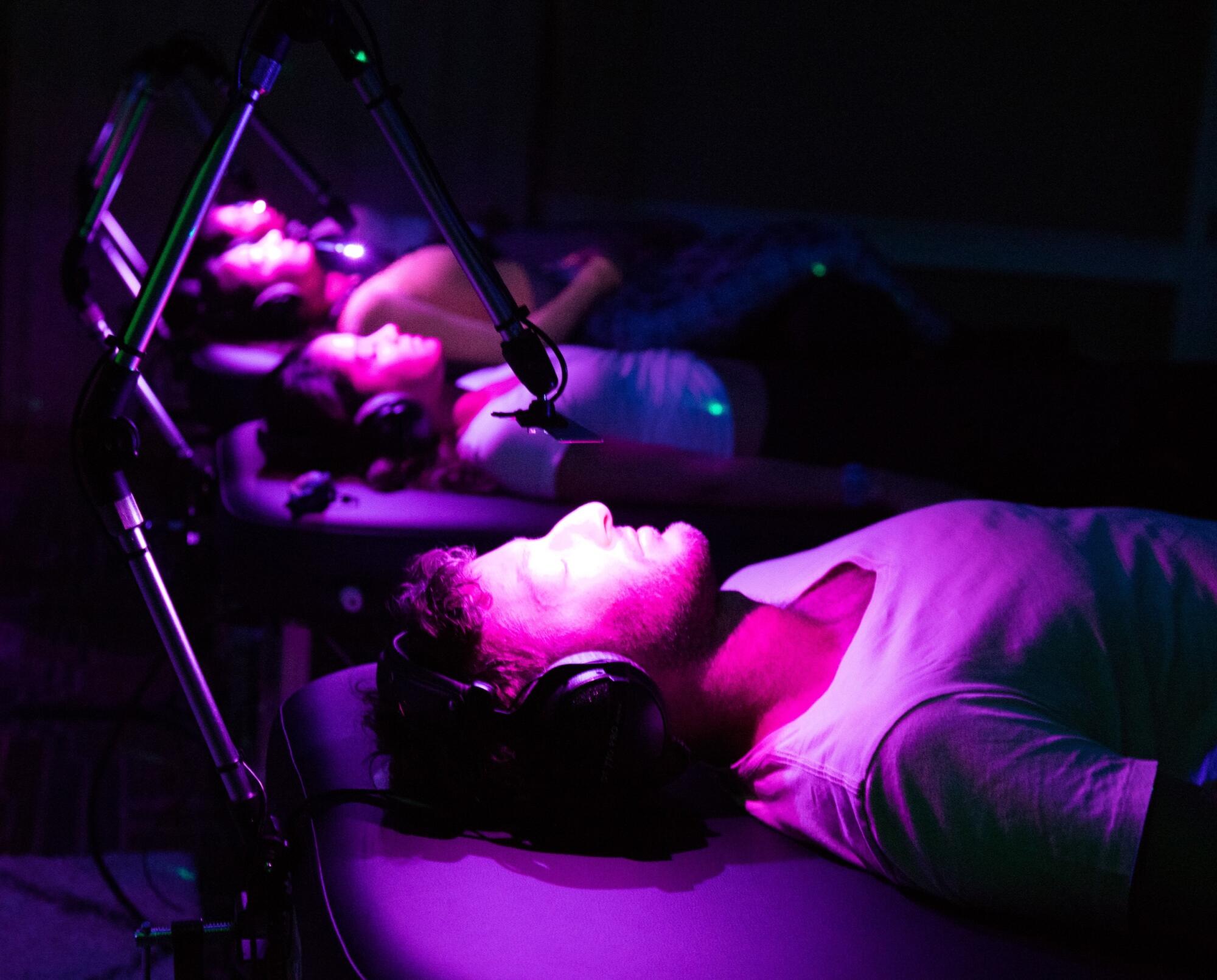
3. It’s super-convenient
The length of a drug-induced trip depends on a lot of factors. If you ingest magic mushrooms, you’re essentially booking a four- to six-hour flight with some lingering effects that can be felt long after that. When you go the digital route, an hourlong session is just that, making it possible for overscheduled Angelenos to wedge this approach to sensory wellness into their lives as easily as booking a massage or taking a yoga class. (The day I visited the center, one of the foursome I arrived with at 11 a.m. said: “I’ve got to be somewhere at quarter of 12, will that be OK?” It absolutely was.)
4. It can be a real trip
I was surprised that the digital trip felt so much like the analog ones I remembered from my college days. Most familiar were the trippy visuals (though here through closed eyes instead of open ones) and the midtrip epiphany, the realization that we’re insignificant specks of dust and integral parts of the great cosmic game plan at the same time.
5. Consider it preflight for a deeper dive
Doubleblind editor in chief Hartman said digital psychedelics — not just the treatments offered at the Reality Center but also virtual reality and augmented reality experiences in the space — also can be valuable for otherwise unprepared first-time psychonauts.
“I think for sure what they can do is give people a sense of what the sensorial experience of being on a psychedelic might be like,” Hartman said. “Specifically when it comes to visuals. If you haven’t done a psychedelic in which you’ve had a strong visual experience, it’s very hard to understand what that’s like — it can be profound and it can be overwhelming.” She explained that the kind of drug-free drug trips served up by the Reality Center can give people an eye-opening sense of what they’re in for if and when they embark on an old-school psychedelic trip.
6. The bottom line
Because the pop-culture ascendancy of the magic mushroom is all but assured (another bill to decriminalize psylocybin in California was introduced late last year), the Reality Center’s biggest value may be that it’s not just giving us a glimpse inside ourselves but at the future too.
More to Read
Sign up for The Wild
We’ll help you find the best places to hike, bike and run, as well as the perfect silent spots for meditation and yoga.
You may occasionally receive promotional content from the Los Angeles Times.

